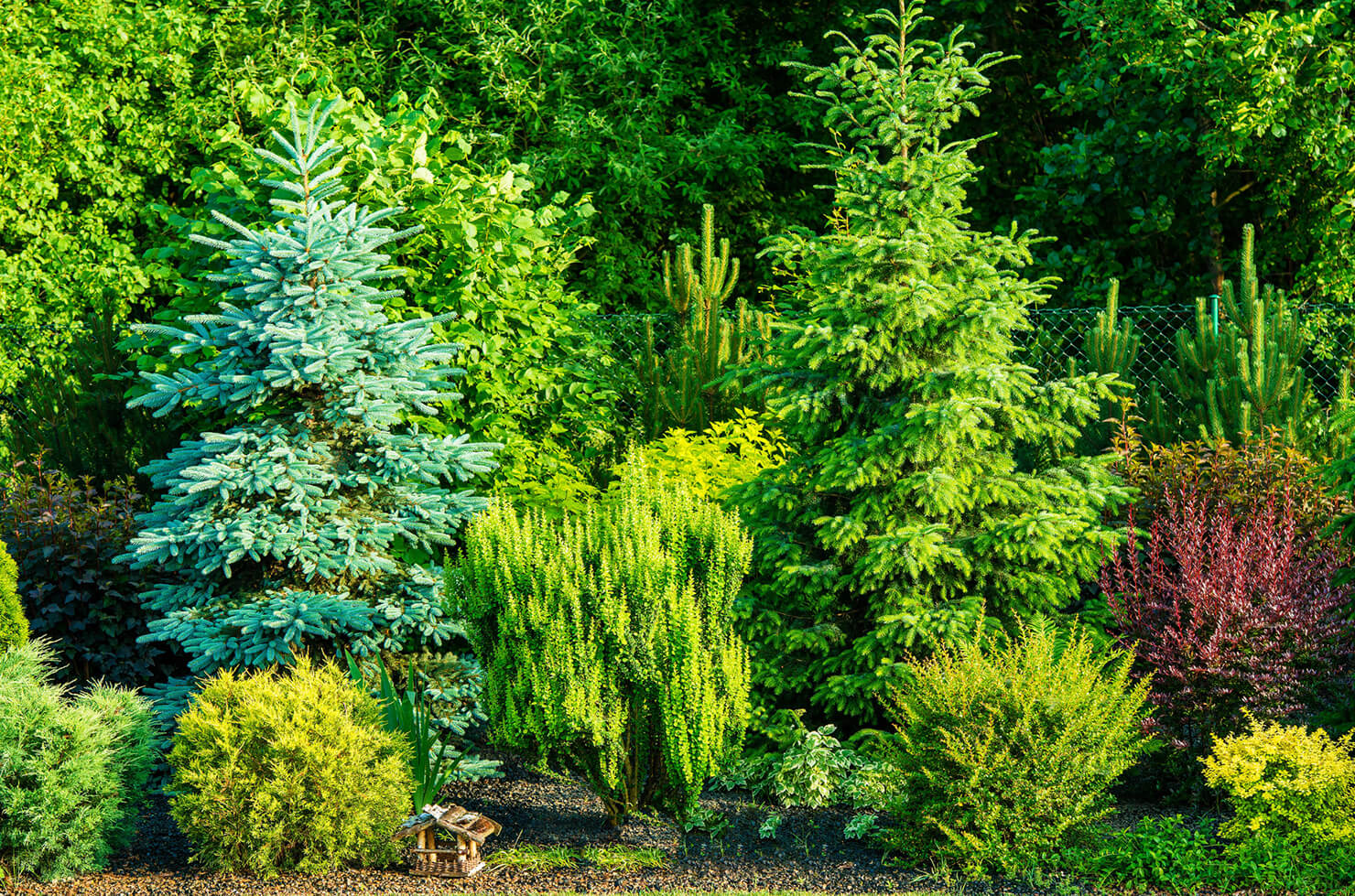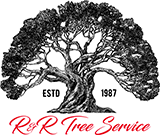In Georgia, where the climate and soil can greatly impact tree health, keeping up with tree maintenance will keep your home and yard looking pristine and will keep your trees healthy and strong.
Check out these top 6 tree maintenance tips for maintaining tree health, from tree trimming practices to how to remove dead trees safely.
1. Regularly Inspect and Monitor Your Trees
Regular inspection is the first step in proper tree maintenance. For newly planted trees, you want to keep an eye on them to ensure they’re growing properly and taking well to their new home, and for established trees, you need to look out for signs of new growth, but also be aware of any changes that may signal problems, such as fungal growths or cracks in the trunk.
Establish a regular routine for inspection to help catch issues before they become severe.
Signs of a Healthy Tree
- Vibrant Leaves or Needles: A healthy tree canopy typically has lush, vibrant foliage. The leaves should be a rich, green color (or appropriate color for the season) without excessive yellowing or browning, which can indicate stress or disease. For evergreen trees, look for bright green needles that are not dry or brittle.
- Strong, Flexible Branches: Branches should be resilient and flexible, with healthy buds. Brittle or dead branches that snap easily often indicate a problem. In the spring and summer, look for new growth, which is a good sign of health.
- Intact Bark: The bark of the tree should be intact and adhere firmly. Cracks, splits, or dead wood can indicate stress or disease. Small amounts of moss or lichen are normal in many environments, but large patches may need further investigation.
- Healthy Root System: While often difficult to assess because most tree roots are underground, visible surface roots should not show signs of damage, decay, or fungus. Strong, extensive root systems are crucial for a tree’s health, as they provide stability, nutrients, and water.
- Steady Growth: Healthy trees grow at a steady rate, which varies by species. Familiarize yourself with the normal growth patterns for your trees to help identify potential problems if growth slows significantly.
- No Excessive Leaf Loss: While deciduous trees shed their leaves in fall, unexpected or excessive leaf loss at other times of the year can signal stress or health issues.
- Resilience to Environmental Stress: Healthy trees are better able to withstand environmental stresses such as drought, extreme temperatures, and pests. If a tree rebounds well after challenging weather conditions, it’s likely in good health.
2. Properly Prune and Trim Your Trees
Tree pruning isn’t just about making your trees look good; it’s vital for the health and safety of your trees. By removing dead branches, you reduce the risk of pests and diseases. It also prevents potentially dangerous limbs from falling during storms.
For fruit trees, strategic pruning can improve sunlight penetration and air circulation, leading to a more abundant harvest. It’s important to understand the best times to prune different types of trees to encourage healthy growth without stressing them, so be sure to research your specific tree type to better understand the pruning schedule.
Basic Tree Pruning Tips
- Know the Best Time to Prune: Generally, late winter or early spring, before new growth starts, is the best time for pruning most trees. However, some trees prefer different times, so it’s worth checking the specific needs of your tree.
- Use the Right Tools: Sharp, clean pruning tools make cleaner cuts and help prevent the spread of disease. Use hand pruners for small branches, loppers for medium branches, and a pruning saw for larger branches.
- Sanitize Your Tools: Clean your tools before and after use, especially if you’re moving between different trees, to prevent spreading disease. A simple solution of bleach or alcohol can be effective.
- Make Clean Cuts: Cut just outside the branch collar (the swollen area where the branch joins the trunk) to promote healing. Avoid leaving a stub, which can be vulnerable to pests and disease.
- Prune Dead or Diseased Branches: Removing these branches helps prevent the spread of disease and pests and encourages healthier growth.
- Thin the Canopy for Light and Air: Remove some branches to allow light and air to penetrate the canopy. This helps reduce the risk of disease and allows for healthier growth.
- Avoid Over-Pruning: Never remove more than 25% of a tree’s canopy in a single season, as this can stress the tree.
- Follow the ⅓ Rule for Young Trees: When shaping a young or newly planted tree, try not to remove branches that are more than one-third of the diameter of the trunk.
- Don’t Top Trees: Cutting the top off trees (topping) can severely damage or even kill your tree. It leads to weak new growth that is more susceptible to disease and damage.
- Consider the Tree’s Natural Form: Try to maintain the natural shape of the tree. Pruning should enhance its natural structure, not alter it dramatically.
- Wear Protective Gear: Safety glasses, gloves, and appropriate clothing can protect you from sharp branches and tools.
- Know When to Call a Professional: If the tree is large, the branches are too high, or if you’re unsure of the proper tree trimming techniques, it’s safest to call a professional tree care company. They have the experience and equipment to do the job safely and correctly.
3. Keep Up With Mulch and Soil Management
A layer of mulch can do wonders for your trees by retaining soil moisture, regulating temperature, and reducing weed competition. The key to success, though, is to apply it correctly. Keep the mulch a few inches away from the tree trunk to prevent moisture buildup and decay.
When it comes to soil, periodic testing can inform you about nutrient deficiencies or pH imbalances, allowing you to address these issues and ensure your trees have the foundation they need to grow strong and healthy.
4. Know How Much and How Often to Water Your Trees
The rule of thumb for watering trees is deep and infrequent watering, which encourages roots to grow deeper into the soil. The amount and frequency will depend on the species, size, and age of the tree, as well as the weather and soil type. Observing the tree’s response to watering and adjusting accordingly can prevent both underwatering and overwatering, which are both detrimental to tree health.
Watering Newly Planted Trees
Newly transplanted trees require special care and attention. Here are some tips for watering new trees properly:
- Water Immediately After Planting: As soon as you finish planting, give the tree a good soaking. This helps settle the soil around the roots and eliminates air pockets, ensuring the roots are in full contact with the soil.
- Establish a Regular Watering Schedule: Newly planted trees need consistent moisture to help their roots grow and establish. Depending on the weather and soil type, a general guideline is to water deeply once a week. In hot, dry weather, you may need to water more frequently.
- Water Deeply and Slowly: It’s better to water deeply and slowly to ensure the water penetrates the soil and reaches the tree’s root system. A slow trickle of water for a longer period is more beneficial than a quick, shallow watering.
- Use a Drip Hose or Soaker Hose: These tools deliver water directly to the base of the tree at a slow rate, ensuring deep water penetration and minimizing waste through evaporation.
- Check Soil Moisture Before Watering: Before watering, check the soil moisture by digging a small hole near the tree’s base (about 6-8 inches deep). If the soil feels dry at that depth, it’s time to water. If it’s still moist, you can wait a bit longer.
- Mulch Around the Tree: Apply a 2-3 inch layer of mulch around the tree, but keep the mulch a few inches away from the trunk. Mulch helps retain soil moisture, reduces temperature extremes, and minimizes weed competition.
- Avoid Overwatering: Overwatering can be just as harmful as under-watering, leading to root rot and other issues. Ensure good drainage in the planting area and adjust your watering schedule based on rainfall and soil conditions.
- Monitor and Adjust: Keep an eye on your newly planted trees as they adjust to their new environment. Signs of under-watering include wilting and yellowing leaves, while signs of overwatering include soggy soil and leaves that are green but droopy.
5. Protect Your Trees From Pests and Diseases
Pests and diseases can significantly impact tree health if not managed properly. Regularly inspect your trees for signs of trouble, such as discolored leaves, wilted foliage, dead branches, or holes in the bark. Consider environmentally friendly options for pest control and disease management to protect your trees and the broader ecosystem from invasive plants and insects. Sometimes, a professional arborist’s insight is necessary to diagnose and treat more severe problems.
6. Protect Your Trees From Environmental Factors
Trees can be surprisingly resilient, but they’re not immune to extreme weather and environmental stress. Take proactive steps to prevent damage from strong winds, extreme cold, and intense heat. For young or vulnerable trees, staking can provide necessary support.
In the event of a particularly cold winter, consider wrapping the trunks of certain trees to protect against cold and pests. For mature trees that pose a safety risk during storms or bad weather, professional tree removal may be the best course of action.
Safety Measures For Tree Maintenance
Whether you’re pruning, trimming, or removing trees, ensuring both personal and property safety can prevent accidents and injuries. Here are some essential safety measures to keep in mind.
Wear the Right Gear
Wear long sleeves, durable pants, and sturdy boots to protect your skin from sharp branches and tools during tree removal or tree trimming. Always protect your eyes from flying debris, dust, and branches by wearing safety goggles. Use gloves to improve grip and protect your hands from cuts and splinters.
If you’re using loud equipment like chainsaws or wood chippers, ear protection is a must to prevent hearing damage. When working under or around trees, a hard hat can protect you from falling branches.
Use the Correct Equipment
One of the best tree maintenance tips we can give is to ensure all tools and equipment are in good working order before starting. Dull or malfunctioning equipment can increase the risk of accidents. Familiarize yourself with how to use each tool properly, whether it’s a chainsaw, pruning shears, ladders, or any other type of equipment.
Be Mindful of Your Surroundings
Check the area for obstacles like power lines, nearby structures, or uneven ground that could pose risks during your work. Make sure the work area is clear of people, especially children and pets, to avoid accidents.
When using a ladder, make sure it’s stable and securely placed on level ground. Always have someone spot you by holding the ladder at the base while you work.
Know Your Limits
Understand the scope of work you can safely handle. If a tree is too large, the branches too high, or if there are power lines nearby, consider hiring professionals. Arborists and tree care professionals have the training, experience, and equipment to handle complex and dangerous situations safely.
When to Call a Tree Care Professional
Despite your best efforts, some situations require professional help. If you’re unsure about the health of your tree, how to properly prune, or if a dying tree needs to be removed, it’s time to call a tree care company. Professionals have the knowledge and equipment to provide proper tree care and ensure your trees continue to enhance your landscape for years to come.
Keep Your Trees Healthy and Thriving With Proper Maintenance

Proper tree maintenance is a continuous effort that pays off in the form of beautiful, healthy trees. From regular monitoring and pruning to managing soil and protecting trees from pests and environmental factors, each step is important in maintaining healthy trees. Remember, healthy trees not only enhance the beauty of your property but also provide shade, fruit, and a habitat for wildlife. With these tips and a little care, your trees will continue to thrive in Georgia’s unique environment.

